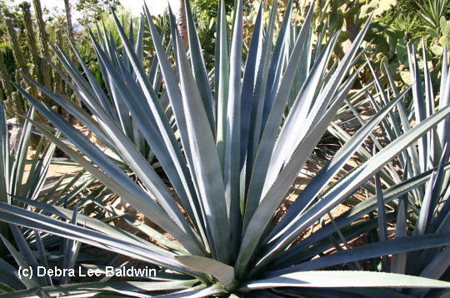What do tequila, green roofs, Guatemala and lawn removal have in common? They’re among the subjects of questions people have emailed me since Designing with Succulents was released. I recently added a Q&A page to my website. You’re invited to see if your own question is here, or just enjoy the others.
Q: I live east of Phoenix in the low desert. I keep redesigning my rock gardens as I learn more about the various plants’ needs, and put shade cloth in front of latticework to protect the succulents where possible in the summer. Do you have any recommendations for types of succulents, not cacti, that do well in desert climates with extreme heat? We do get an occasional freeze, but heat is more likely to kill our plantings.
A: In the open garden, you can grow elephant’s food (Portulacaria afra), all types of agaves (such as Agave americana, shown above), hesperaloes, yuccas and dasylirions. And learn to love cactus! The more I get into succulents, the more of an appreciation I gain for elegantly geometric mammillarias, rebutias and more. Also, there’s no point in combating nature. In my own 1/2 acre garden, which I’ve cultivated for 20 years, I quickly tire of finicky plants. But I do have patio containers full of succulents that would be difficult to grow in the ground. Containers let me monitor and shelter the plants as needed, moving them to protect them from the elements and the vicissitudes of the garden. Which is why I wrote Succulent Container Gardens —to make cultivation easier for people who live in less-than-desirable climates.
Q: I thought I would try your recommendation of using just moss for wreaths and round metal hanging balls. In your book you said sphagnum moss but would green moss work too? The latter comes in big bales from Oregon.
A: Yes, green moss is what the designers use. That’s a confusing term, though, because it’s yellowish, and not readily available to the casual hobbyist. I suggested sphagnum moss because it’s sold by the bag by craft stores and nurseries.
Q: Where might I purchase some of the Guatemalan folk art buildings you used in your containers book (p 196)?
A: The little terracotta buildings are from Miranda’s, a Mexican import store in the Old Town district of San Diego (2548 Congress St.). Unfortunately, they don’t sell mail order, nor do they keep a consistent supply in stock. But any dollhouse-sized building will work, so long as it’s waterproof—like this little New England-style church that was originally a Christmas ornament. There are all sorts of wonderful tiny accessories for miniature landscapes. Two Green Thumbs is one mail order source.
Q: We’re interested in putting succulents on the roof of a small storage building in Southern CA. How would you go about it?
A: Green roofs are primarily a cool-climate phenomenon, and the succulents used for them mainly sedums and sempervivums. In the dry, hot Southwest, plants on rooftops bake in summer, there isn’t enough rainfall to keep them going, and what the heat doesn’t kill, winter frosts may. The only flora that might have a chance would be desert plants. You might use multiples of dwarf agaves or barrel cacti (which from a distance would provide a marvelously nubby look). As for construction, your green roof will need a moisture barrier to protect the structure—which also may need to be reinforced to hold the additional weight—and some means of irrigation (such as drip). There’s an excellent book by Ed Snodgrass about constructing green roofs, and a great deal of info online as well.
Q: I’m going to yank out the grass in my San Diego front yard to save the water. Should we line the soil before we put in better draining soil to prevent grass growing back through? What soil mix do you recommend for succulents?
A: To kill a lawn, turn off the sprinklers. If that doesn’t do it, treat it with Round-Up (chemicals are a last resort). Then break up the sod with shovels or a rototiller, and turn under. Let it regrow, then repeat the process. Amend the soil prior to planting. Aim to enhance porosity and to make the soil slightly acidic. Good amendments for succulents include pumice, coarse perlite, crushed lava stone, and/or lime (as needed for porosity and pH). Weather conditions also are a factor. Homeowners in your area will want a less moisture-holding mix than, say, those in Phoenix. Also, the type of plants make a difference. A cactus garden needs a faster-draining blend than a lush and leafy succulent garden. For more info, see Designing with Succulents, page 22. And when it comes out next year, get expert Carol Bornstein’s book on lawn removal.
Q: Is blue agave, Agave tequilana var. Weber, the one that is used for making tequila, essentially the same variety as Agave americana?
A: No. Tequila has to be made from Agave tequilana or its not tequila. The plant is grown commercially throughout Mexico and harvested when the sugar content is high, right before blooming. The leaves are trimmed away from the pineapple-like core, which is then roasted and distilled. I’ve never heard of anyone trying to ferment Agave americana, though doubtless it’s been tried because the plant is common and easy to grow. The tequila agave (shown here) makes a beautiful landscape plant, with slender blue leaves and a crisp silhouette.
So, have I addressed your question? I’d love to hear from you!
My goal is to share the beauty of waterwise, easy-care succulents in gardens, containers and landscapes via blog posts, newsletters, public speaking and workshops, photos, videos, merchandise, and social media (Facebook and Pinterest). My books: Designing with Succulents, Succulent Container Gardens, and Succulents Simplified. www.debraleebaldwin.com



